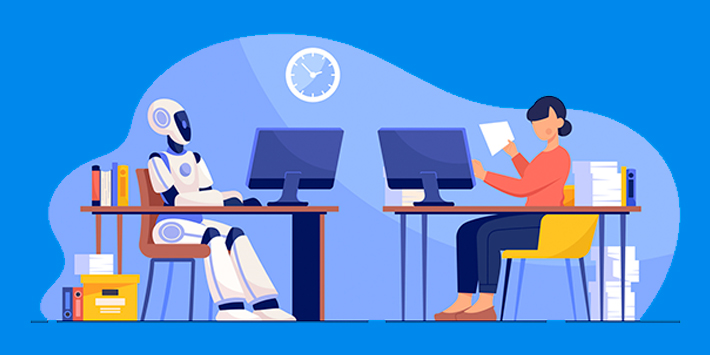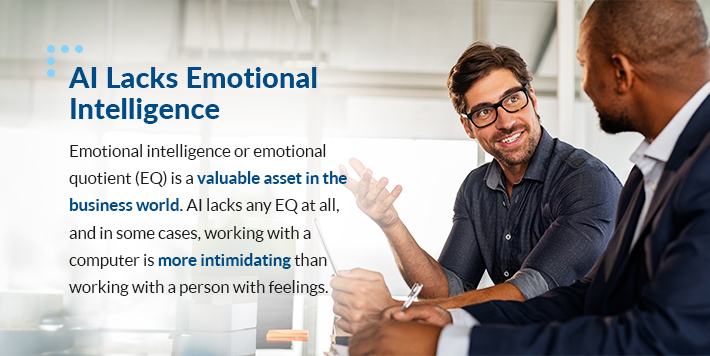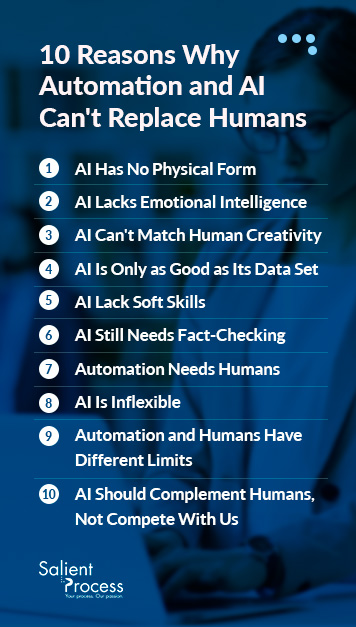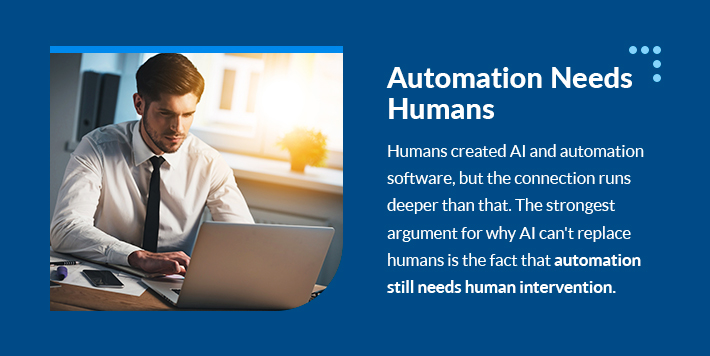
Is the future of the workplace destined to be run by artificial intelligence (AI) and completed by automated systems? Will AI replace humans? The short answer is no. The long answer requires a deeper look and an understanding of AI and automation. First, let’s break down these two technologies.
AI is a science that helps machines learn how to perform tasks and solve problems. From doing mundane and repetitive admin tasks to generating actionable insights based on enormous amounts of data, AI can complete many tasks that humans can’t, or tasks that would take humans much longer to complete.
Many forms and applications of artificial intelligence exist. One of the most common and basic forms of AI is language-model-based chatbots, where users can enter queries and get results. For example, a user could ask an AI chatbot to write a resume based on a specific set of skills, and the AI would use that data and its knowledge of the information on the internet to write that resume. These tools have their limitations, which we’ll explore later on.
Similarly, automation technology streamlines processes in a way that requires little to no human interaction. Automated systems improve efficiency and can perform tasks without stopping. For example, payment apps and automatic car washes involve automated systems that complete tasks humans can do in a more efficient way. In work settings, robotic process automation (RPA) can complete simple, tedious tasks like moving digital files, extracting data, and completing data entry.
With these terms and their definitions in mind, we can explore their limitations and discover how they can only assist humans, not replace them.
Some tasks require dexterity and physical intervention. Outside of robots, which can only complete very specific tasks, AI and automation software have no physical forms to accomplish tasks beyond the screen. For example, AI can’t handle tasks requiring hand-eye coordination, and they’re unsuitable for completing work that can change direction quickly. While automated machinery can assist with some laborious actions like moving boxes, it’s not developed enough to completely replace human workers and their physical abilities.
Some of the most common areas for AI implementation are warehouse planning and inventory management. AI can help create efficient layouts and management systems, but implementing those plans is a job only humans can handle. Farming is another major industry in which AI can help but where human workers are still necessary. Overall, AI is only capable of completing certain job duties, and humans must be available to handle more complex physical tasks that can arise on any job site.

Emotional intelligence or emotional quotient (EQ) is a valuable asset in the business world. EQ is the ability to predict a reaction and act accordingly. In theory, the greater a worker’s EQ, the better they will work and interact with others. AI lacks any EQ at all, and in some cases, working with a computer is more intimidating than working with a person with feelings. Many job roles require EQ, like team managers, teachers, counselors, and therapists.
Most AI tries to mimic human intelligence, but it has no way of simulating or interpreting emotions. To understand emotion, AI needs to know how to interpret human experiences, not just intelligence. Feeling emotions is what makes us human, and translating this to a machine is likely impossible.
Beyond designing AI to understand emotions, it needs to show EQ when interacting with users. An apt way of putting this lack of EQ is that you can trust what an AI tells you to do but not how it tells you to do it. Our emotional intelligence helps us figure out how to tackle problems in relation to ourselves. AI has no sense of self and struggles to instruct us beyond simple, logical instructions. Method, motivation, and improvisation are still exclusive to humans.
Jobs requiring no EQ or emotional connections are where AI and automation shine — and these opportunities are limited in many cases. By using these tools to complete mundane, repetitive tasks, we can make better use of EQ by giving humans more time to work in situations involving it. As stated, RPA can be highly beneficial for completing simple, redundant tasks, allowing human workers to focus on more complex and creative work that requires EQ.
Instances where AI helps humans can result in a better product. Through the use of AI, creative jobs are more accessible than ever. Using AI as a tool can help those with creative visions achieve their intended results.
Letting AI have complete control over creative projects has its limits. As humans, our creative vision is always evolving, and we can gain inspiration for situations and experiences at any time. An AI creativity tool will produce a finished result in an instant — without the room to expand the concept beyond the initial stages. AI also works with preset data and won’t stray from this data, whereas humans have limitless creative potential by comparison.
AI and humans can achieve synergy in creative fields when working together to achieve a goal. However, the current view in the industry is to keep them separated or have them compete. The creativity and EQ of humans, paired with the efficiency and accuracy of AI, may lead to achievements in creative works. While it’s impossible for automation to be as creative as humans, it could be beneficial for AI to be used in small areas of creative work.
The intelligence of artificial intelligence is easy to confuse as genuine. AI software works by extracting data to create the answer it thinks best answers your queries. The AI tool you choose to use can only do what its input data allows it to do. In other words, your data needs to be able to guide your AI to give you the answers and insights you need.
By giving your AI tool more information and the latest relevant customer data to work with, it can generate more accurate and useable insights. As a result, humans will likely always be necessary to operate specific AI tools — they add data to these applications, and without data, AI can’t operate. Overall, AI is only as good as the data human workers feed it or create for it.

Soft skills are non-technical skills that define how people interact and work with others. These are sought-after skills in most companies in every industry. Valuable soft skills include respectfulness, negotiation, confidence, friendliness, adaptability, team-building, innovation, and creativity. AI lacks the soft skills required to be a proper part of a team.
Humans develop soft skills through training and experience. They improve over time, and everyone, regardless of their job, likely needs to learn at least a few soft skills. Machines can’t learn these skills, just like they’re unable to understand and feel emotions. No AI or automation software can fully replicate the necessary smart skills that a human can, meaning humans will always be necessary to be part of and lead teams in this way.
Not everything produced by an AI tool is perfect. There is a lot of misinformation created by artificial intelligence that needs to be fact-checked. AI analyzes the data available to it to create a natural-sounding response based on the language models it uses. This process makes it easy to produce believable misinformation on a large scale. While using AI to check AI might be a good idea, there are still issues with doing so.
AI that uses news sources and other websites to inform its outputs is susceptible to misinformation. If it’s using data that gets the facts wrong, it’ll also produce false results. Further, missing a point’s nuance or lacking specificity are common mistakes found in written AI work. As a result, human workers are still required to verify results and adjust as necessary.

Humans created AI and automation software, but the connection runs deeper than that. The strongest argument for why AI can’t replace humans is the fact that automation still needs human intervention. Using a human-in-the-loop system keeps us involved in a way that produces the best results, whether it’s fact-checking or AI maintenance.
Whether it’s a robot that moves boxes in a warehouse or an RPA tool that completes simple digital processes, humans are necessary to oversee and correct these actions when necessary. People are also required to train automation tools and processes in most cases. As a whole, it seems that humans will always be part of the process when it comes to the use of AI and automation.
Automation and AI software are made to follow strict rules to produce the right results. While these programs excel in certain fields, they’re only able to operate by abiding by their rules. In comparison, humans can accomplish a task even when presented with obstacles. This ability to improvise and use their own initiative to reach a goal is where humans have a notable advantage over machines.
For example, if a sudden issue arises on a job site, it’s much easier to tell a team of human workers how to pivot and solve the problem than attempt to redirect any automated machinery on the site. Ultimately, automation in the workplace is only capable of fulfilling specific job duties. In many instances, humans are more than equipped to take on a variety of tasks and adjust their approach to said tasks when necessary.
As humans, we can use our emotions and experiences to shape the way we work. In addition, certain limitations make us human — we get tired, we need to eat, we require motivation, and we need to be healthy both physically and mentally. Despite this, we have a lot of strengths that make us valuable. We’re able to learn, have common sense to guide us, and interact and communicate to work together and achieve great things.
While AI may have limitless energy, it’s bound by the extent of its code and data. Humans are more versatile and can do anything from physical work to complex thinking and research.
Further, AI has no moral compass or limitations. As an example, a 2003 thought experiment involved instructing AI to produce paper clips. In the end, the AI’s calculations ended up converting everything on the planet into paperclip production facilities. This lack of boundaries and guidance shows that AI prioritizes its task above all else. Even decades later, this paper shows that AI has a great weakness that makes humans better leaders and action-takers.
Overall, the purpose of artificial intelligence is to help humans rather than replace them. While automation is ideal for tasks that require repetitive motions or other redundancies, AI is an inappropriate substitute for jobs that require reasoning, soft skills, and adaptability. The focus should be on how AI can help us rather than replace us or become something we rely on.
As workplace demands evolve, the need for humans increases. The World Economic Forum released a report in 2020 showing 97 million new jobs will be made available as a result of AI, showing that there are many jobs that AI can’t replace. Clearly, new opportunities will arise as AI advances. There is a way for humans and AI to complement each other without needing to compete.
Humans and machines can outperform each other in various ways. Understanding the limits of AI and automation means you can optimize the way you use its strengths. With the right automation system, your business can thrive, and your employees can get more done than ever before.
Salient Process can provide you with the tools you need to take your business to the next level. Using our Digital Business Automation solutions, you can enhance your workflow, automate tasks, manage your content, and achieve many other crucial tasks, all while empowering your team of employees. To find out more about what we can offer you, contact us today.